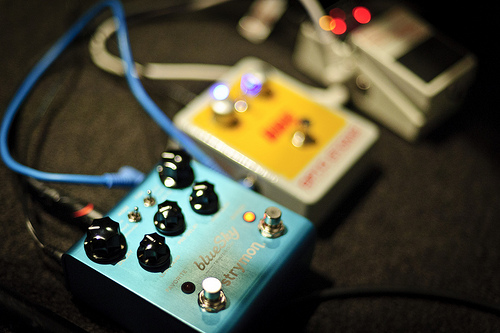Like most effects, reverb can be used with varying degrees of subtlety and manipulation, from the barest touch of extra warmth to the full-on twang of a classic spring reverb. Picking the right pedal, whether analog or digital (we have recommendations for both), will be easier when you consider exactly what you want it for before shopping around. Especially consider your primary usage; a studio musician may want a pedal that’s larger and more complex, while a guitarist who mostly plays live shows might favor portability and simplicity over the number of functions.
Here are the 5 best reverb pedals on the market:
TC Electronic Hall of Fame (Digital)
This little pedal gives you all of the iconic reverbs you could want in a compact, highly portable, and surprisingly affordable package. It’s got 10 different reverb styles, from spring to plate to the spacious echo of a church. The level controls give you a wide range of options to make your sound as bright or dark as you’d like, and it has an analog dry through so your sound will only be improved, never altered. If none of the pedal’s options are quite right for you, the Hall of Fame also lets you upload your own custom reverbs, giving you truly endless options. If you want digital, this is one of the best reverb pedals for the money.
Electro-Harmonix Holy Grail Max Reverb (Digital)
Electro-Harmonix offers a variety of different reverb pedals, and whatever your tastes and inclination you’re likely to find something in the line that suits your style. If you want to experiment with the brand and aren’t sure where to start, the Holy Grail Max gives you the most sonic options and has been called the perfect reverb pedal by some industry experts. It keeps the same highly-touted spring and hall reverbs of the original Holy Grail but adds plate and reverse reverb options to give you even more to play with. You can further shape the effect with the blend and time dials, resulting in a fully-customizable reverb effect.
Electro-Harmonix Holy Grail Nano (Digital)
If you don’t have much to spend, you’ll find the best value with another Electro-Harmonix product: the Holy Grail Nano. A simplified version of the similar Holy Grail Plus and Holy Grail Max pedals, it offers three reverb styles—spring, hall, and flerb, an Electro-Harmonix original flanged reverb. Though it has fewer options, it executes them to perfection. Its emulation of a classic spring reverb is all but indistinguishable from an analog and the hall reverb is lush and open. The simple, single-dial interface can be easily controlled with your foot during a live performance, and the clear tone works beautifully with other pedals in your effects rig.
Carl Martin Headroom (Analog)
If you’re looking for a true spring reverb sound, digital emulations rarely live up to the real deal. You’d need the best analog reverb pedals. The Carl Martin Headroom gives you that classic spring reverb twang in a relatively compact package. Any analog spring reverb is going to be larger than a normal pedal by necessity—the spring chamber has to go somewhere—but the Headroom is small enough to be considered portable. The spring tray is suspended inside the chassis and the base is insulated with rubber, minimizing the extra noise that can often result from hitting a spring reverb’s footswitch a little too hard. Two available pre-sets let you quickly and easily change the level of the effect on the fly.
Caroline Meteore Lo-Fidelity Reverb
Another option on the analog side of things is this limited edition throwback pedal: The Caroline Meteore. It brings you true analog spring reverb with interactive controls that give you way more customization options than your traditional string reverb-style pedal. And it’s a powerful little pedal, too, capable of getting to pretty massive volume levels without losing any of the purity of the sound.
All Caroline pedals are made by hand in small batches—the “limited edition” in the name of this model isn’t just for show—so you know you’ll get something that’s well-built inside and out. Just one look at the vintage-styled aesthetics of this pedal and you’ll know you’re getting a one of a kind effect, with the unique texture you’re looking for from an analog spring reverb pedal. This is among the best analog reverb pedals on the market.
Types of Reverb
Most digital reverb pedals produce a wide range of potential sounds. Hall, chamber, and room reverbs are exactly what they sound like—an emulation of what the listener would hear if the musician were playing in that kind of space. Hall reverb is typically longer, lasting one to three seconds, and has a bright start with a tapering decay that gives the sound a warm tone. Chamber reverbs are similar with a shorter decay, and room reverbs are live on the attack with a quick decay. These styles of delay are typically aimed at enhancing rather than altering the instrument’s sound.
Spring reverb, on the other hand, can be a more noticeable effect to the layman’s ears. Whereas the analog equivalent of the reverbs above would be playing in those physical spaces, digital spring reverb is an emulation of the analog style still used today in units like the Carl Martin Headroom above. The spring model was the first attempt made at man-made reverb, which had previously been controlled in studios with modifications to the room instead of to the recorded sound. Spring reverb has a sharper edge than other styles and—though it does enhance the sound—is noticeably different than a natural reverb. This historically led sound engineers to create the plate reverb, which was first made in analog form by vibrating a sheet of metal to reflect the sound.
Most digital reverb pedals will include an emulation of plate reverb, as well, and it’s a more subtle coloring of the tone than its spring predecessor, creating a full, smooth sound without adding the depth you’d get from a hall reverb. Plate reverb is popular for this reason, because it makes it easier to add warmth without sacrificing clarity.
Every digital reverb pedal on the market will feature some combination of the styles mentioned above, as well as other tweaked variants of their own design, like the Electro-Harmonix. If you’re not sure which style of reverb you want to use—or if you play in a variety of ensembles and want to tailor your sound—the Hall of Fame and Holy Grail Max (see full specs) will give you the most options. On the other hand, neither will give you the bright spring of the Carl Martin, for example, and some of the most distinctive reverb pedals can’t be duplicated.
If you have other friends who play guitar, ask if you can borrow their pedal for a day to test how it gels with your guitar and amp and get a true sense of how it’ll shape your sound. Barring that, a trip to the local music store could be enlightening. It may take some searching to find the best guitar reverb pedal for you, but the depth it can add to your tone will make it ultimately worth the effort. Good luck!









